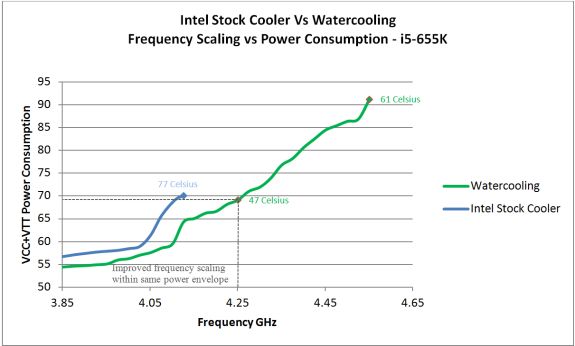Now that we’ve got a couple of baselines out of the way using Intel’s stock heat-sink, it’s time to peg thermals back a bit on and see how the i5-655K substrate responds to lower load temperatures:

Switching over to our water-cooling loop decreases load temperature deltas by up to 35 degrees Celsius on this sample (as reported by on-die DTS). The upshot of this is seen quite clearly in the graph - lower load temperatures decrease processor power consumption at equivalent frequencies due to a positive temperature co-efficient (the hotter the CPU runs the more power it leaks - all else being equal). With the end result being that we’re able to boost our previous 3.77GHz stock VID overclock using the stock Intel cooler by almost 200MHz to 3.953GHz.
The improved thermal dissipation allows us to ramp voltages and takes us all the way to 4.55GHz before we hit the wall of diminishing returns. The demands on voltage ramping past this point are such that we start to see a minimum 5~10 watt rise in power consumption for every 20MHz increase in frequency. Also note, that we’re about 40MHz away from doubling up on stock processor power consumption; 4.25GHz seems to be the sensible operating point, coming in at 16 Watts over stock power draw to VCC and VTT with a 900MHz boost in full-load core frequency - and that’s with all performance related domains overclocked.











51 Comments
View All Comments
Ph0b0s - Friday, May 28, 2010 - link
Not covered so much on these websites but I slurged on an I7 965 when I7's were new, becuase it was unlocked, even though I knew it did not have any extra head room than the cheap chips in the family. The reason I did this was so that I could use the I7's new turbo feature to overclock on demand instead of having to use static timings to overclock. With unlocked I7's and the right motherboard you can change the value of the turbo mulipliers to be more than just one or two steps.So for my chip if I have all 4 cores in use my turbo muliplier is set to x29 (3800 ghz, only using factory voltages at the moment) and higher amounts when less cores are in use. So when not doing anything my CPU clocks itself to 1.6 GHz and runs at 3.2 GHz if not doing too much and then clocks itself to 3.8GHz when extra power is needed.
So I really welcome Intel putting out these cheaper unlocked CPU's, as next time when I want to overclock using the turbo funtionality I won't have to fork out for an Extreme Edition again.
Also I would love to see more coverage of this type of overclocking that it is new with the Nathelems, Before it was only the I7 Extreme Edition chips that could do it, but now that are more options avaliable, maybe Anandtech could do an article taking about it.
Death666Angel - Friday, May 28, 2010 - link
Hello guys!I was really looking forward to Intel -K material. But the whole bunch of "i5 540" is more than an annoyance. It is downright embarrassing and I would urge you to re-read any future texts, as I am really not interested in reading stuff when so little time is put into the text. Really a shame since the content is looking good.
Rajinder Gill - Friday, May 28, 2010 - link
Sorry, blame me for that. Those skipped under the radar this morning.-Raja
Griswold - Friday, May 28, 2010 - link
If you wonder why Intel does this, it most likely boils down to two letters: BE. They were never priced as if they came straight out of Absurdistan. And perhaps Intel felt a little itch because of that...Maroon - Friday, May 28, 2010 - link
^^^we have a winner!DanNeely - Friday, May 28, 2010 - link
Where are you getting those numbers from? Software or are you using hardware to measure it directly off the mobo itself?Rajinder Gill - Friday, May 28, 2010 - link
Hardware measured using a clamp meter.Raja
DanNeely - Sunday, May 30, 2010 - link
So you were measuring the current going into the mobo via the 4/8pin 12V cpu power cable?Rajinder Gill - Monday, May 31, 2010 - link
Yes.DanNeely - Tuesday, June 1, 2010 - link
Did you also monitor the main ATX power connector to see if there was any increase in power draw there when overclocking?